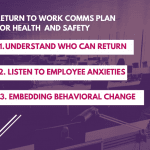Coronavirus has left in its wake millions of employees across the globe now working from home and potentially working from home for the foreseeable future.
Managing ergonomics in our traditional workplace is relatively easy. We know how people work. Subject to the nuances associated with agile environments, employees usually have a desk, a computer, and a five-castor chair.
Now that people are working from home, we are adapting quickly to a wider variety of working habits and postures – working from the sofa, the dining room table, or kitchen stool.
With COVID-19 still around, many employers are reluctant to immediately bring colleagues back to the workplace. In the medium- to long-term, it’s likely many of us will remain homeworkers or adopt a much more flexible working routine with home working becoming more of the norm.
Homeworking and managing risk
I have written before about home working and the need for risk assessments. It is my view, and that of legal professionals, that many regulations require risk assessments for home working.
I’d like to expand on this argument by looking at global obligations for managing ergonomics risks at home through the lens of health and safety and the concept of accountability.
Regulations apply in a vast number of countries across the world. Having said that, not many countries have dedicated ergonomics regulation.
That does not mean obligations don’t exist, however, as general health and safety and/or labor laws will apply. In many cases, the obligation is not on the individual to seek help but for the employers to push that help to the individual. This is often at odds with company policy, but it is an important distinction.
Employees may need to account for their own ergonomics, in a limited sense, by ensuring they listen to the advice given; but, employers have the obligation to deliver training and support to that employee.
By not complying with this requirement an employer could experience greater levels of culpability should a claim be made by an injured employee.
The obligation exists, it’s just you might not know it yet
As I mention above, most countries have general health and safety laws or specific ergonomics laws. In those that don’t, employers should look to the International Labour Organisation (ILO) for key principles in health and safety management. I’ll get to those shortly.
The most important thing to take away is that even where it might appear that homeworker ergonomics is not covered, employers have an obligation to ensure help is provided. Whether that’s under national or local regulations or under the principles of the ILO.
Where this is not undertaken culpability is increased and any associated penalties will match this level of culpability.
The Key Principles Under the ILO
The key principles discussed under the ILO’s principles are as follows:
“Each employer should include within their Occupational Health and Safety Management System, as a minimum, the following key principles and objectives to which the organization is committed:
- Protecting the safety and health of all members of the organization by preventing work-related injuries, ill health, diseases, and incidents;
- Complying with relevant OSH national laws and regulations, voluntary programs, collective agreements on OSH and other requirements to which the organization subscribes;
- Ensuring that workers and their representatives are consulted and encouraged to participate actively in all elements of the OSH management system; and
- Continually improving the performance of the OSH management system.”
As you can clearly see, employers have an obligation for preventing work-related injuries. It doesn’t matter if they are in the office or at home; the outcome is the same.
It’s not on your employee to account for ergonomics
Working from home and flexible working creates foreseeable risks, such as ergonomics, psychosocial, technological, etc. These risks are foreseeable, therefore, action must be taken to mitigate them.
Education is often the central part of any regulated framework. The employee has to be made aware of the risks and provided with the information needed to lessen these risks. Assessment is often needed, although it may not be directly specified in Labor law.
Flexible workers are especially at risk, as many employers forget there is an obligation to the home environment. If an employer is directing their staff to work from home 1-2 days a week without giving them the option to work in a formal office, they are making the home the workplace.
This is often true for casual homeworkers if they are being allowed to work from the home frequently.
It’s not on your employee to account for ergonomics; you must make them aware of the risks and provide information to reduce them.
Regulations from around the globe
In an effort to highlight how these same guiding principles work across the globe, I’ve brought together a few health and safety and labor law examples from different countries.
Brazil
- Law 12,551 /2011: It gives the same expected labor rights to the teleworkers as the ones of work performed in the establishment of the employer.
This example is clear. Teleworkers are treated the same as those in the workplace.
Germany
- Arbeitsschutzgesetz (Health and Safety at Work Act) – Persons comparable to employees within the meaning of section 5 (1) of the Labor Courts Act(Arbeitsgerichtsgesetz, ArbGG), excluding domestic workers and those equal in law to domestic workers, within the context of the definition the Health and Safety Work Act applies to the teleworker or home-based office worker
Again, the example is clear. The Health and Safety Work Act in Germany covers employees in and out of the office.
Japan
- Occupational Safety Labor standards related laws are applied. (3) Points to be noted in occupational safety law: As with regular workers, when employing workers who work at home, it is necessary to implement safety and health education (Article 59 paragraph 1 of the Occupational Safety and Health Act). In addition, from the viewpoint of securing the health of the workers themselves, in order to maintain the health of workers engaged in teleworking, the business operators are asked to review the “Guidelines for Occupational Health Management in VDT (Video terminal display) Work” (April 5, 2002 0405001), etc.
Employers are obligated to provide education for homeworkers and to review their work in view of the guidelines on VDT work.
Morocco
- Labor Code No. 65-99: Article 2 The provisions of this Act shall also apply to: 30 employees working at home. Article 24 The employer is obliged to take all necessary measures in order to safeguard the safety, health and dignity of employees in the performance of the tasks. Employer shall also be obliged to communicate to employees in writing the provisions relating to different subjects including legal provisions and measures concerning the preservation of health and safety, and the prevention of machine-related risks.
Employers are obligated to tackle health, safety, and the dignity of employees when working at home.
Among these 4 examples, the message is clear – that there is an obligation for employers to treat the health, safety, and wellbeing of homeworkers with the same attention as they would an employee based at an employer’s workspace.
The key message is you have an obligation to homeworkers whether you like it or not.
Coronavirus may have made it much more real and apparent, but looking to the future and a world in which there may be many more homeworkers, it’s vital we take our obligations seriously for our employees and our company.
Cardinus specializes in developing, launching, and managing global ergonomics programs for many hundreds of organizations. We can advise on your regulatory requirements in 191 countries. For help, please don’t hesitate to reach out to us.






